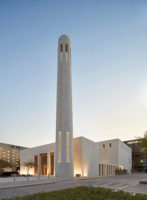Spokane
For most of us, a hospital emergency room rarely induces feelings of peace and tranquility. But Mahlum Architects’ Seattle office made that a top priority in the new 28,000-square-foot pediatric emergency expansion it designed for the Providence Sacred Heart Medical Center in Spokane. At least, it’s calm on the interior. The exterior conveys a more vibrant sensibility.
The pavilion’s brightly colored aluminum panels clad a rectilinear structure that cantilevers dramatically toward the street, out over a gray aluminum and glass base. On the red-paneled second level, a glassed-walled playroom is recessed from the south facade and framed by yellow panels on the walls and soffit of the setback to give the surfaces more articulation. The steel canopy for a car drop-off flanking the east facade adds a sculptural note.
Visitors enter the new building by way of a narrow double-height glazed atrium where separate doors lead to a waiting area for children in the new wing, or for adults being admitted to an adjoining facility. A larger glazed atrium down the hall connects to the existing main hospital to the north. These vertical shafts of space help introduce natural light into an institutional setting, as do the glass walls of the coffee shop on the first floor, facing the street.
The main pediatric area occupies a large, open rectangular space on the ground floor, where the architect arranged the 17 exam rooms around the perimeter, with the staff area at the center. Sliding glass doors for the individual rooms allow them to be visually monitored, and Mahlum also came up with colorful wall graphics and indirect lighting to help reduce anxiety among the young patients. Other features are meant to reduce stress as well. For example, the architect consolidated all of the medical equipment on a single horizontal band above each bed to keep the occupants from being overwhelmed by a jumble of plugs and cords. (In order to test out its ideas, the design team created a full-scale mock-up of a typical patient room and invited the staff to critique it.)
On the upper floor, a quiet seating area, with upholstered chairs and wood-paneled walls, imparts a domestic ambience for family members and visitors. Where the hall on the north turns into a bridge cutting across the northern double-height atrium, the architect covered the end wall with a photo-mural of a forest.
The glass-walled children’s play area on that level has views to the south and east, of a small healing garden across the street and the city beyond. The toys, books, games, videos, and soft cushions in the play area are just one small benefit of the $3 million donation to the new wing from the Rypien Foundation. Mark Rypien, the former National Football League star and the Super Bowl’s Most Valuable Player in 1992, created the charity after his son died of cancer at age three. “The Rypien Foundation was very engaged with these spaces,” says McVey. “It wanted an environment that felt very safe, very nonclinical.”
“It’s almost too successful,” says Michael Kelly, the hospital’s director of facilities. “Patients and visitors from all over the complex come here to relax and escape the normal stress of a hospital stay.”
People
Owner:
Architect:
Personnel in architect's firm who should receive special credit:
Engineers :
Civil:
Mechanical:
Electrical:
Consultant(s):
Lighting:
Acoustical:
Other:
General contractor:
Photographer: Size: 28,000 square feet Construction Cost: $18.6 million Project Cost: $24 million Completion Date: January 2013 |
Products
Structural system
Exterior cladding
Aluminum Composite Metal:
Moisture barrier:
Wood Composite Panels:
Roofing
Metal Roof and Soffits:
Glazing
Skylights:
Doors
Metal doors:
Wood doors:
Sliding doors:
Security grilles:
Fire Doors:
Hardware
Closers:
Exit devices:
Pulls:
Security devices:
Interior finishes
Suspension grid:
Cabinetwork and custom woodwork:
Paints and stains:
Wall coverings:
Plastic laminate: Solid surfacing: LG Hausys Hi Macs
Floor tile in public spaces:
Resilient flooring:
Carpet:
Wall Graphics:
Lighting
Downlights:
Task lighting:
Exterior:
Dimming System or other lighting controls:
Decorative Fixtures:
Conveyance
Plumbing
Energy
Add any additional building components or special equipment that made a significant contribution to this project: |










